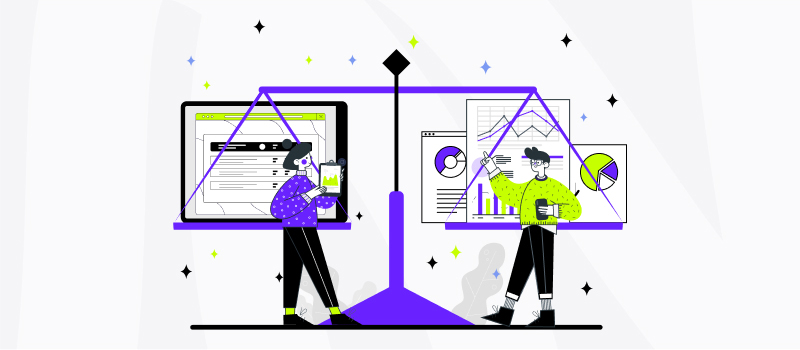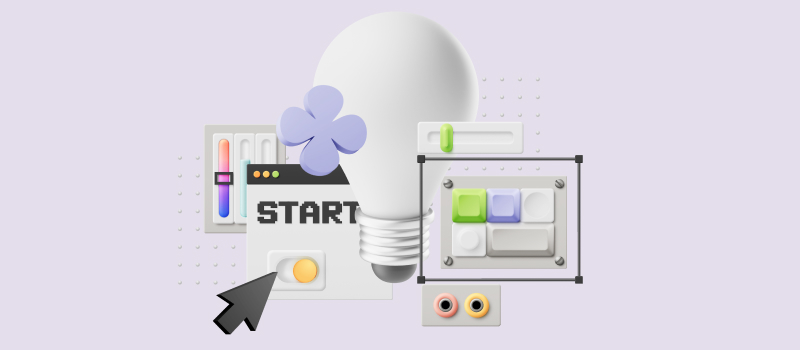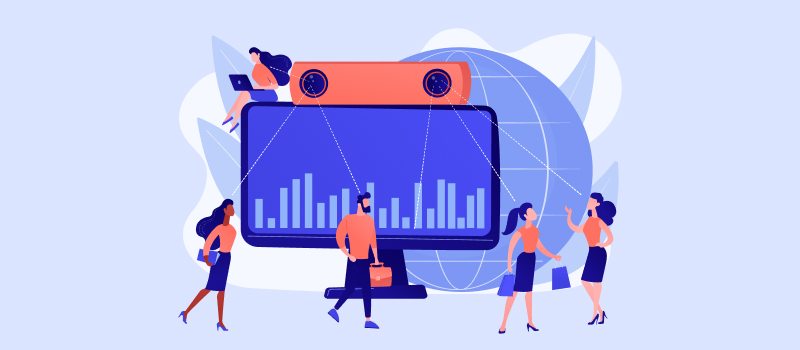
Remote work growth, technology acceleration, and arising cyber-security risks demand a granular understanding of employee activity in the workplace. This in turn increases the interest to the employee monitoring software and surveilance systems.
Despite the concerns about privacy and potential misuse employee monitoring can become a valuable tool for prevent accidents, boost performance, and improve overall wellbeing.
What Is Employee Monitoring?
Employee monitoring refers to the practice of employers logging and tracking various aspects of their employees’ activities in the workplace.
It involves collecting data on employees’ work-related communications, computer usage, internet browsing, time and attendance, location, and more.
Employee monitoring is aimed at preventing security breaches, identifying inefficiencies or productivity issues, and workplace misconduct, and ensuring compliance with legal and industry regulations.
It also helps employers understand how employees are utilizing resources, such as time, equipment, or software licenses, and improve resource allocation and planning. But not everything in the garden is rosy…
Employee Monitoring Pros and Cons
Despite its undeniable benefits employee monitoring has some drawbacks too.
Security vs Privacy. Though monitoring can help detect and prevent unauthorized access, and data leaks, protecting sensitive company information, it can also be seen as an invasion of employee personal boundaries, eroding trust and creating a sense of constant surveillance.
Productivity vs Job Satisfaction. Despite providing valuable insights into employee work habits and time consumption, monitoring can negatively impact employee morale and job satisfaction, leading to decreased motivation, engagement, and potentially higher turnover rates.
Resource Optimization vs Focus on Quantity. Monitoring definitely lets employers reduce unnecessary costs, but when done wrong, it can create a culture that prioritizes quantity over quality, stifling creativity and innovation.
Misconduct Prevention vs Ethical Concerns. While helping to identify and address such issues as harassment or disrespectful behavior, monitoring still poses certain risks to employee privacy rights. There is also a risk of monitoring systems being misused or abused, potentially leading to discrimination and unfair treatment.
To address the listed cons, employers should strike a balance between monitoring for legitimate purposes and respecting employee privacy. Establishing clear policies, providing transparency, and open communication can help mitigate the negative impacts and maintain a positive work environment.
Employee Monitoring Software Types
An employee monitoring system is a software or tool that enables employers to track and monitor various aspects of their employees’ activities in the workplace. It collects data on employee performance, behavior, and usage of company resources.
The extent and types of monitoring technologies used can vary depending on the organization, industry, and legal requirements.
Here are some common examples:
- Computer and internet monitoring software. These tools track employees’ computer usage and internet activities. They can make screenshots and capture information such as websites visited, applications used, keystrokes logged, and time spent on various tasks.
- Time and attendance tracking systems. These systems automate the recording of employee work hours, breaks, and time off. They can use various methods like biometric scanners, electronic badges, or mobile apps to track and manage attendance data.
- Video surveillance systems. These systems can be installed in common areas, production floors, retail spaces, or other locations to ensure security and safety. They use video cameras to monitor employees’ activities in the workplace.
- GPS tracking systems. GPS tracking technologies are used to monitor the location of employees, particularly those who work outside the office or drive company vehicles.
- Communication monitoring tools. These tools capture and analyze employee communications such as emails, instant messages, or phone calls. They can help ensure compliance with company policies, prevent data leaks, and detect any inappropriate or unauthorized activities.
- Activity monitoring and productivity tracking tools. These tools monitor and measure employees’ productivity and work activities. They may track metrics like completed tasks, time spent on different projects, or specific work-related goals.
It’s important to note that employers should implement these technologies responsibly, considering employee rights and legal requirements and maintaining a balance between monitoring and fostering a positive work environment.
Using tools like actiTIME can help you reach this goal without extra effort.
- Flexible settings let employees select the way they want to track and record their activities.
- Automated notifications ensure everyone remembers to submit their timesheets.
- Adjustable permissions guarantee that the data about employee activities and performance is only available to authorized managers.
- Insightful reports provide detailed analytics of employee productivity, project costs, and resource allocation.
Introducing an Employee Monitoring System in Your Company
As you can guess selecting and implementing an employee monitoring system is quite a challenge as you need to ensure compliance with privacy laws, create a dedicated policy, and communicate it to your employees.
Legal Aspects of Employee Monitoring
Legal substantiation of employee monitoring strongly depends on the jurisdiction and industry, but in general, you should consider the following aspects:
- Applicable laws. These may include data protection laws, privacy laws, labor laws, and industry-specific regulations. You should also be aware of any legal obligations and restrictions that apply to your organization specifically.
- Employee consent. In some jurisdictions, obtaining employee consent may be required before implementing certain monitoring practices. Review the legal requirements regarding consent and ensure that employees are properly informed about the monitoring activities and their rights. Document and maintain records of employee consent where necessary.
- Security regulations. Implement measures to protect the data collected through monitoring. Safeguard employee data by utilizing secure storage and access controls. Adhere to applicable data protection laws, such as encryption, anonymization, and data retention requirements.
- Legitimacy. Ensure that your monitoring activities are justified by legitimate business purposes. Monitoring should be proportional to the objectives you aim to achieve, such as security, productivity, compliance, or safety. Avoid excessive or unnecessary monitoring that may infringe on employee privacy rights.
- Confidentiality. Clearly define who has access to monitoring data and how it will be used. Limit access to authorized personnel only and use the data solely for the intended purposes, such as performance evaluation, security investigations, or compliance monitoring.
Unless you have a legal expert in your team it pays to consult a lawyer to learn more about the specific laws and regulations applicable to your organization and jurisdiction.
Ethical Aspects of Employee Monitoring
In addition to legal considerations, you should also take into account the ethical aspects of employee monitoring.
Here are some points to consider:
- Transparency. Clearly communicate to employees that monitoring may be conducted in the workplace. Provide detailed information about the purpose, methods, and scope of monitoring.
- Purpose limitation and data retention. Use monitoring data solely for the intended purposes, such as performance evaluation, security investigations, or compliance monitoring. Avoid retaining monitoring data longer than necessary and establish clear guidelines for data retention and disposal.
- Fairness and non-discrimination. Ensure that monitoring practices are applied consistently and fairly to all employees. Avoid using monitoring data for discriminatory purposes or treating employees unfairly based on the information collected.
- Employee involvement and feedback. Involve employees in the development of monitoring policies and seek their feedback. Consider their perspectives and concerns to ensure that monitoring practices are balanced and respectful of their rights.
An Employee Monitoring Policy: Checklist and Template
A workplace monitoring policy is a set of guidelines and rules that outline how employee monitoring will be conducted in an organization.
It will help you launch the monitoring system smoothly while maintaining clarity and a positive attitude. Moreover, in some states like Ontario, New York, or California, an employee monitoring policy is obligatory for companies, applying dedicated practices.
To help you get started we have prepared a short checklist of what to include in your policy and a template you can use right away.
6 Steps to an Effective Employee Monitoring Policy
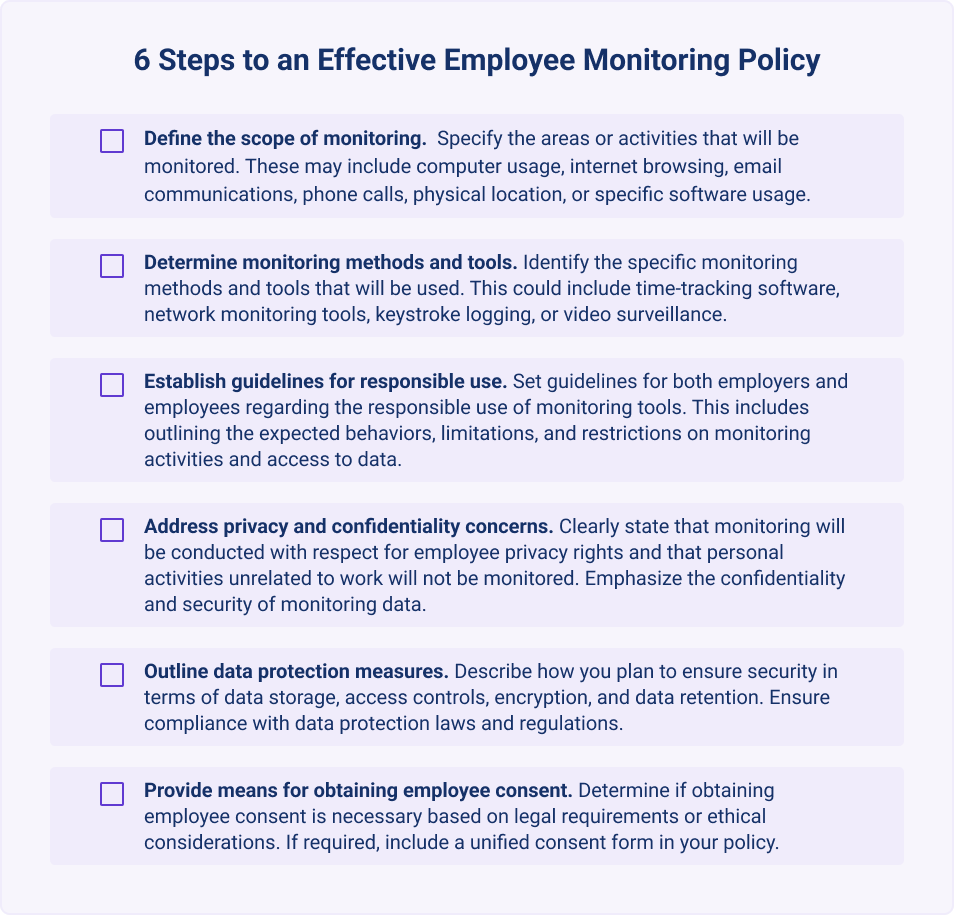
Employee Monitoring Policy Template
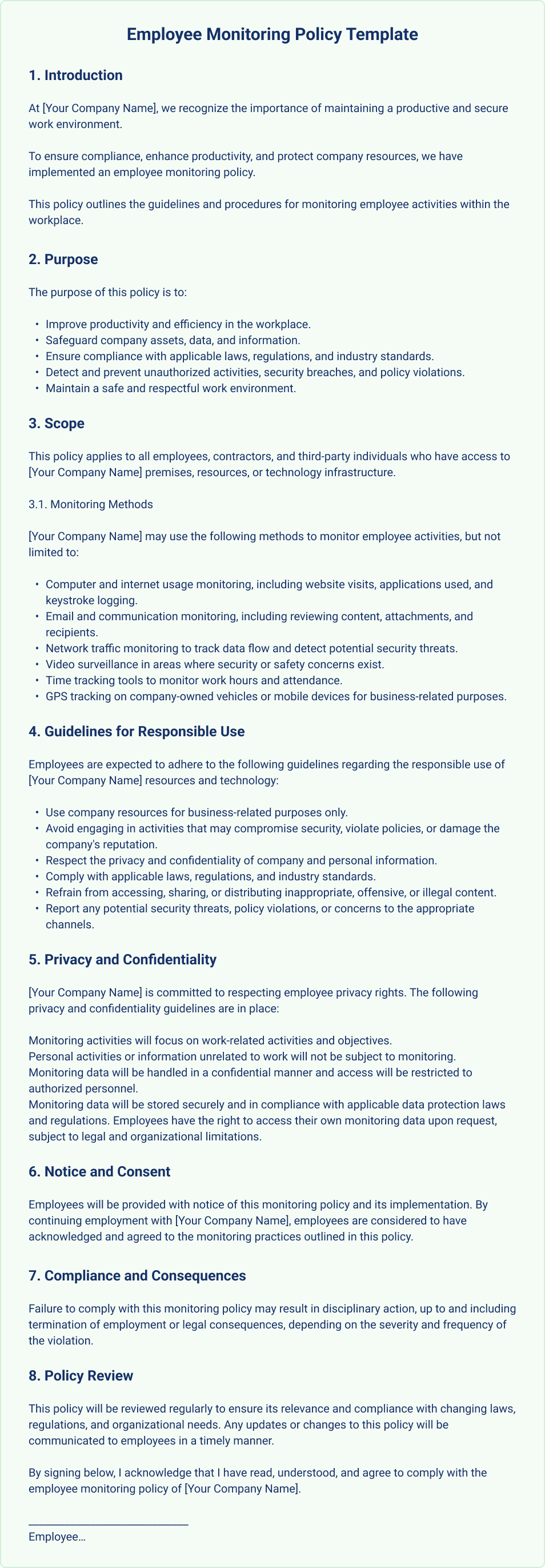
The Final Word
When done right employee monitoring can provide several benefits for both employers and employees. It can facilitate more accurate performance evaluations and feedback discussions, improve time management and task prioritization, ensure fair distribution of work, and help you enhance overall business security and protect valuable assets.
To ensure effective employee monitoring, it is essential to consider the following:
- clear objectives,
- transparent communication,
- legal and ethical compliance,
- straightforward policy,
- effective monitoring system.
actiTIME is a smart time tracking tool that can make your employee monitoring a breeze:
- Flexibility and customization. actiTIME allows businesses to define their own work structure, project hierarchy, and time tracking rules. This flexibility ensures that the monitoring system aligns with the unique requirements of the organization.
- Corporate-level security. actiTIME provides secure data storage, access controls, and encryption to protect sensitive information.
- Integrations. actiTIME integrates with other popular tools, such as project management software, customer relationship management (CRM) systems, and accounting software. This helps streamline monitoring processes and enhance data accuracy across different systems.|
Sign up for a free actiTIME trial today to monitor your employees respectfully!














































